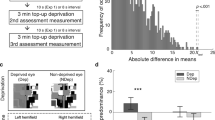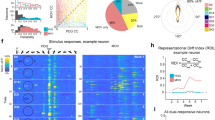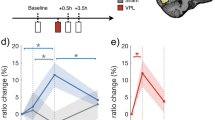Abstract
A myriad of mechanisms have been suggested to account for the full richness of visual cortical plasticity. We found that visual cortex lacking Arc is impervious to the effects of deprivation or experience. Using intrinsic signal imaging and chronic visually evoked potential recordings, we found that Arc−/− mice did not exhibit depression of deprived-eye responses or a shift in ocular dominance after brief monocular deprivation. Extended deprivation also failed to elicit a shift in ocular dominance or open-eye potentiation. Moreover, Arc−/− mice lacked stimulus-selective response potentiation. Although Arc−/− mice exhibited normal visual acuity, baseline ocular dominance was abnormal and resembled that observed after dark-rearing. These data suggest that Arc is required for the experience-dependent processes that normally establish and modify synaptic connections in visual cortex.
This is a preview of subscription content, access via your institution
Access options
Subscribe to this journal
Receive 12 print issues and online access
$209.00 per year
only $17.42 per issue
Buy this article
- Purchase on Springer Link
- Instant access to full article PDF
Prices may be subject to local taxes which are calculated during checkout








Similar content being viewed by others
References
Tropea, D., Van Wart, A. & Sur, M. Molecular mechanisms of experience-dependent plasticity in visual cortex. Phil. Trans. R. Soc. Lond. B Biol. Sci. 364, 341–355 (2009).
Gordon, J.A. & Stryker, M.P. Experience-dependent plasticity of binocular responses in the primary visual cortex of the mouse. J. Neurosci. 16, 3274–3286 (1996).
Mrsic-Flogel, T.D. et al. Homeostatic regulation of eye-specific responses in visual cortex during ocular dominance plasticity. Neuron 54, 961–972 (2007).
Kaneko, M., Stellwagen, D., Malenka, M. & Stryker, M.P. Tumor necrosis factor-α mediates one component of competitive, experience-dependent plasticity in developing visual cortex. Neuron 58, 673–680 (2006).
Frenkel, M.Y. & Bear, M.F. How monocular deprivation shifts ocular dominance in visual cortex of young mice. Neuron 44, 917–923 (2004).
Bear, M.F., Kleinschmidt, A., Gu, Q.A. & Singer, W. Disruption of experience-dependent synaptic modifications in striate cortex by infusion of an NMDA receptor antagonist. J. Neurosci. 10, 909–925 (1990).
Hensch, T.K. et al. Local GABA circuit control of experience-dependent plasticity in developing visual cortex. Science 282, 1504–1508 (1998).
Taha, S., Hanover, J.L., Silva, A.J. & Stryker, M.P. Autophosphorylation of alphaCaMKII is required for ocular dominance plasticity. Neuron 36, 483–491 (2002).
Heynen, A.J. et al. Molecular mechanism for loss of visual cortical responsiveness following brief monocular deprivation. Nat. Neurosci. 6, 854–862 (2003).
Allen, C.B., Celikel, T. & Feldman, D.E. Long-term depression induced by sensory deprivation during cortical map plasticity in vivo. Nat. Neurosci. 6, 291–299 (2003).
Crozier, R.A., Wang, Y., Liu, C.H. & Bear, M.F. Deprivation-induced synaptic depression by distinct mechanisms in different layers of mouse visual cortex. Proc. Natl. Acad. Sci. USA 104, 1383–1388 (2007).
Shepherd, J.D. & Huganir, R.L. The cell biology of synaptic plasticity: AMPA receptor trafficking. Annu. Rev. Cell Dev. Biol. 23, 613–643 (2007).
Yoon, B.J., Smith, G.B., Heynen, A.J., Neve, R.L. & Bear, M.F. Essential role for a long-term depression mechanism in ocular dominance plasticity. Proc. Natl. Acad. Sci. USA 106, 9860–9865 (2009).
Goel, A. & Lee, H.K. Persistence of experience-induced homeostatic synaptic plasticity through adulthood in superficial layers of mouse visual cortex. J. Neurosci. 27, 6692–6700 (2007).
Desai, N.S., Cudmore, R.H., Nelson, S.B. & Turrigiano, G.G. Critical periods for experience-dependent synaptic scaling in visual cortex. Nat. Neurosci. 5, 783–789 (2002).
Frenkel, M.Y. et al. Instructive effect of visual experience in mouse visual cortex. Neuron 51, 339–349 (2006).
Plath, N. et al. Arc/Arg3.1 is essential for the consolidation of synaptic plasticity and memories. Neuron 52, 437–444 (2006).
Messaoudi, E. et al. Sustained Arc/Arg3.1 synthesis controls long-term potentiation consolidation through regulation of local actin polymerization in the dentate gyrus in vivo. J. Neurosci. 27, 10445–10455 (2007).
Guzowski, J.F. et al. Inhibition of activity-dependent Arc protein expression in the rat hippocampus impairs the maintenance of long-term potentiation and the consolidation of long-term memory. J. Neurosci. 20, 3993–4001 (2000).
Park, S. et al. Elongation factor 2 and fragile X mental retardation protein control the dynamic translation of Arc/Arg3.1 essential for mGluR-LTD. Neuron 59, 70–83 (2008).
Waung, M.W., Pfeiffer, B.E., Nosyreva, E.D., Ronesi, J.A. & Huber, K.M. Rapid translation of Arc/Arg3.1 selectively mediates mGluR-dependent LTD through persistent increases in AMPAR endocytosis rate. Neuron 59, 84–97 (2008).
Shepherd, J.D. et al. Arc/Arg3.1 mediates homeostatic synaptic scaling of AMPA receptors. Neuron 52, 475–484 (2006).
Rial Verde, E.M., Lee-Osbourne, J., Worley, P.F., Malinow, R. & Cline, H.T. Increased expression of the immediate-early gene arc/arg3.1 reduces AMPA receptor–mediated synaptic transmission. Neuron 52, 461–474 (2006).
Lyford, G.L. et al. Arc, a growth factor and activity-regulated gene, encodes a novel cytoskeleton-associated protein that is enriched in neuronal dendrites. Neuron 14, 433–445 (1995).
Steward, O. & Worley, P.F. Selective targeting of newly synthesized Arc mRNA to active synapses requires NMDA receptor activation. Neuron 30, 227–240 (2001).
Dölen, G. et al. Correction of fragile X syndrome in mice. Neuron 56, 955–962 (2007).
Sawtell, N.B. et al. NMDA receptor–dependent ocular dominance plasticity in adult visual cortex. Neuron 38, 977–985 (2003).
Daw, N.W., Reid, S.N. & Beaver, C.J. Development and function of metabotropic glutamate receptors in cat visual cortex. J. Neurobiol. 41, 102–107 (1999).
Tagawa, Y., Kanold, P.O., Majdan, M. & Shatz, C.J. Multiple periods of functional ocular dominance plasticity in mouse visual cortex. Nat. Neurosci. 8, 380–388 (2005).
Wang, K.H. et al. In vivo two-photon imaging reveals a role of arc in enhancing orientation specificity in visual cortex. Cell 126, 389–402 (2006).
Vazdarjanova, A. et al. Spatial exploration induces Arc, a plasticity-related immediate-early gene, only in calcium/calmodulin-dependent protein kinase II-positive principal excitatory and inhibitory neurons of the rat forebrain. J. Comp. Neurol. 498, 317–329 (2006).
Kalatsky, V.A. & Stryker, M.P. New paradigm for optical imaging: temporally encoded maps of intrinsic signal. Neuron 38, 529–545 (2003).
Tropea, D. et al. Gene expression changes and molecular pathways mediating activity-dependent plasticity in visual cortex. Nat. Neurosci. 9, 660–668 (2006).
Porciatti, V., Pizzorusso, T. & Maffei, L. The visual physiology of the wild-type mouse determined with pattern VEPs. Vision Res. 39, 3071–3081 (1999).
Cang, J., Kalatsky, V.A., Ouml Wel, S. & Stryker, M.P. Optical imaging of the intrinsic signal as a measure of cortical plasticity in the mouse. Vis. Neurosci. 22, 685–691 (2005).
Chowdhury, S. et al. Arc/Arg3.1 interacts with the endocytic machinery to regulate AMPA receptor trafficking. Neuron 52, 445–459 (2006).
Kim, T.J., Ye, E.A. & Jeon, C.J. Distribution of AMPA glutamate receptor GluR1 subunit–immunoreactive neurons and their co-localization with calcium-binding proteins and GABA in the mouse visual cortex. Mol. Cells 21, 34–41 (2006).
Lu, W. & Constantine-Paton, M. Eye opening rapidly induces synaptic potentiation and refinement. Neuron 43, 237–249 (2004).
Pfeiffenberger, C. et al. Ephrin-As and neural activity are required for eye-specific patterning during retinogeniculate mapping. Nat. Neurosci. 8, 1022–1027 (2005).
Smith, S.L. & Trachtenberg, J.T. Experience-dependent binocular competition in the visual cortex begins at eye opening. Nat. Neurosci. 10, 370–375 (2007).
Gianfranceschi, L. et al. Visual cortex is rescued from the effects of dark rearing by overexpression of BDNF. Proc. Natl. Acad. Sci. USA 100, 12486–12491 (2003).
Rittenhouse, C.D. et al. Stimulus for rapid ocular dominance plasticity in visual cortex. J. Neurophysiol. 95, 2947–2950 (2006).
Roberts, E.B., Meredith, M.A. & Ramoa, A.S. Suppression of NMDA receptor function using antisense DNA blocks ocular dominance plasticity while preserving visual responses. J. Neurophysiol. 80, 1021–1032 (1998).
Di Cristo, G. et al. Requirement of ERK activation for visual cortical plasticity. Science 292, 2337–2340 (2001).
Cho, K.K., Khibnik, L. & Philpot, B.D. The ratio of NR2A/B NMDA receptor subunits determines the qualities of ocular dominance plasticity in visual cortex. Proc. Natl. Acad. Sci. USA 106, 5377–5382 (2009).
Waltereit, R. et al. Arg3.1/Arc mRNA induction by Ca2+ and cAMP requires protein kinase A and mitogen-activated protein kinase/extracellular regulated kinase activation. J. Neurosci. 21, 5484–5493 (2001).
Sato, M. & Stryker, M.P. Distinctive features of adult ocular dominance plasticity. J. Neurosci. 28, 10278–10286 (2008).
Fagiolini, M., Pizzorusso, T., Berardi, N., Domenici, L. & Maffei, L. Functional postnatal development of the rat primary visual cortex and the role of visual experience: dark rearing and monocular deprivation. Vision Res. 34, 709–720 (1994).
Coleman, J.E., Law, K. & Bear, M.F. Anatomical origins of ocular dominance in mouse primary visual cortex. Neuroscience 161, 561–571 (2009).
Cynader, M. Prolonged sensitivity to monocular deprivation in dark-reared cats. J. Neurophysiol. 43, 1026–1040 (1980).
Acknowledgements
We thank T. Emery for assistance with the preparation of the manuscript. We thank members of the Sur and Bear laboratories for their comments and helpful discussions. This work was supported by grants from the US National Institutes of Health (C.L.M., D.T. and M.S.) and the Howard Hughes Medical Institute (J.D.S. and M.F.B.).
Author information
Authors and Affiliations
Contributions
C.L.M. and J.D.S. conducted experiments and data analysis and wrote the manuscript. D.T. assisted with optical imaging experiments. K.H.W. provided the Arc−/− mouse line. M.S. and M.F.B. helped design experiments and supervised the project.
Corresponding authors
Ethics declarations
Competing interests
The authors declare no competing financial interests.
Supplementary information
Supplementary Text and Figures
Supplementary Figures 1–9 (PDF 3502 kb)
Rights and permissions
About this article
Cite this article
McCurry, C., Shepherd, J., Tropea, D. et al. Loss of Arc renders the visual cortex impervious to the effects of sensory experience or deprivation. Nat Neurosci 13, 450–457 (2010). https://doi.org/10.1038/nn.2508
Received:
Accepted:
Published:
Issue Date:
DOI: https://doi.org/10.1038/nn.2508
This article is cited by
-
ARC/Arg3.1 expression in the lateral geniculate body of monocular form deprivation amblyopic kittens
BMC Ophthalmology (2023)
-
Anaesthetic-dependent changes in gene expression following acute and chronic exposure in the rodent brain
Scientific Reports (2020)
-
Synapse development organized by neuronal activity-regulated immediate-early genes
Experimental & Molecular Medicine (2018)
-
Mir-132/212 is required for maturation of binocular matching of orientation preference and depth perception
Nature Communications (2017)
-
Structural plasticity upon learning: regulation and functions
Nature Reviews Neuroscience (2012)



